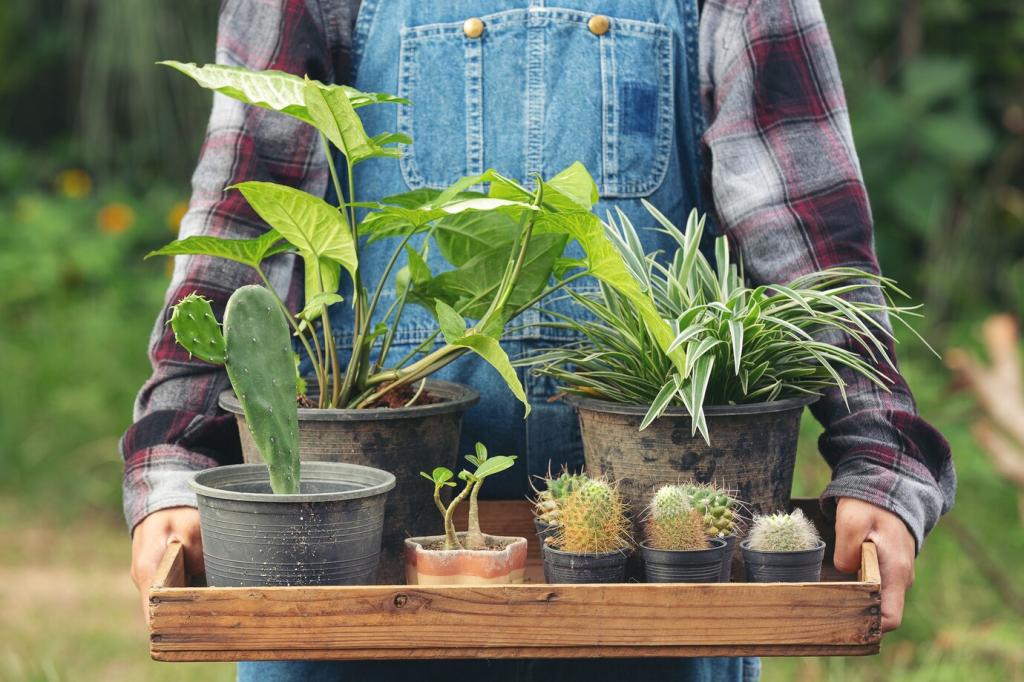Balcony Gardens: Extending Your Indoor Green Space
Vertical gardening techniques turn plain balcony walls or railings into thriving oases. Installing shelves, trellises, or hanging planters allows you to layer greenery upwards, amplifying plant variety without encroaching on valuable floor space. Vines, trailing flowers, and even vegetable climbers can cascade or ascend, adding visual depth and lushness. Vertical gardens also improve privacy and insulate against noise, making balconies more peaceful. Selecting suitable containers and structural supports ensures that your vertical green wall remains secure and healthy in changing weather. With regular care and strategic placement, your balcony can become a living tapestry, offering both function and delight in a compact footprint.

Understanding Sunlight and Wind Patterns
Every balcony has a unique relationship with sunlight and exposure to wind. South-facing spaces may be bathed in sunshine, while northern ones can be cool and shade-drenched. Before choosing plants, observe your balcony’s microclimate throughout the day, noting how light and wind vary at different times. Certain species flourish in full sun, while others prefer dappled shade or can withstand gusts. Recognizing these patterns guides you toward plants that will not only survive but thrive. Additionally, strategically placed screens or taller plants can shield sensitive species from harsh conditions. Awareness of your balcony’s unique environment ensures that your green space flourishes season after season.
Choosing Edibles, Ornamentals, or a Blend
Balcony gardens can provide more than aesthetic pleasure—they can yield fresh herbs, compact vegetables, or bursts of color from ornamental blooms. Choosing between food-producing and decorative plants—or thoughtfully blending both—depends on your personal goals and available space. Edible plants like salad greens, cherry tomatoes, or dwarf fruit varieties are well-suited to containers and reward you with home-grown flavor. In contrast, ornamental species add instant appeal and may attract beneficial pollinators. Combining edibles with decorative plants can create an engaging, productive landscape, merging beauty and bounty. Careful planning ensures both kinds coexist harmoniously, enhancing your experience while maximizing your balcony’s potential.
Selecting Low-Maintenance or Specialty Plants
Your lifestyle should influence plant selection—choose low-maintenance species if you prefer a forgiving, easy-care garden, or opt for specialty varieties if you crave a unique challenge. Succulents, hardy herbs, and evergreen shrubs are excellent for gardeners seeking simplicity while still achieving lush effects. Conversely, exotic blooms or sensitive ferns require more attention but reward dedication with their unusual beauty. Factor in your time commitment, watering habits, and enthusiasm for nurturing challenging plants. Whether you desire a set-it-and-forget-it retreat or an eclectic living collection, your balcony can be tailored to reflect your approach and enhance your everyday living.
Maintaining a Thriving Balcony Ecosystem
Watering Strategies for Container Gardens
Balcony gardens in containers require careful watering, as pots dry out faster than garden beds—especially when exposed to wind or strong sunlight. Achieving the right moisture balance demands observation, as both overwatering and dehydration can stress plants. Consider grouping containers with similar water needs and using self-watering pots to reduce maintenance. Early morning or dusk are ideal watering times, minimizing evaporation and preventing fungal issues. Mulching the surface can also help retain moisture, curbing water usage while nourishing roots. By adopting sensible watering strategies, you set the foundation for a vibrant, enduring balcony garden, ensuring your plants remain healthy and flourishing year-round.
Organic Fertilizing and Soil Renewal
Unlike open ground, container soil can quickly become depleted of nutrients. Regularly replenishing soil with organic fertilizers—such as compost tea or slow-release pellets—supports plant vigor and encourages robust growth. Refresh the top layer of soil seasonally, removing compacted or spent material and replacing it with enriched substrates. Pay attention to each plant’s feeding schedule to avoid over-fertilization, which can harm roots or cause imbalances. Organic practices contribute to a more sustainable, environmentally conscious garden while ensuring your balcony ecosystem continues to thrive. By prioritizing soil health, you foster resilience and longevity in even the most confined green spaces.
Managing Pests and Encouraging Beneficial Insects
Healthy balcony gardens thrive when pest populations are managed naturally, minimizing the need for chemicals. Encouraging beneficial insects, such as ladybugs and lacewings, helps control common pests like aphids. Use a diverse plant palette—incorporate flowering herbs or native species to attract helpful pollinators and predators. When issues arise, physical barriers or homemade remedies can target unwelcome visitors without harming your ecosystem. Monitoring leaves for early signs of infestation enables swift intervention, preserving plant health and balance. By fostering a dynamic, integrated system, you ensure your balcony serves as an inviting habitat for both people and pollinators while keeping challenges manageable.
